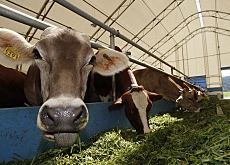
Farmers continue to feel the squeeze

The number of Swiss farms decreased last year compared with 2003, continuing the downward trend.
The Federal Statistics Office says one-third of all Swiss farms have disappeared over the past 15 years. The results confirm the tendency in Switzerland towards larger holdings and organic farming.
According to the survey of the farming sector published on Thursday, between 2003 and 2005 more than 2,200 farms ceased to exist – a 3.4 per cent drop.
From 92,815 farms in 1991, there are now only 63,627 left in Switzerland – representing a 31 per cent decrease over this period.
Those going out of business were mostly small farmsteads working less than 20 hectares of land. This led to a 39 per cent increase in the number of holdings with over 20 hectares.
From 1991 the average size of a farm in Switzerland went from 11.5 to 16.7 hectares.
Proponents of reform say that further reductions are needed and argue that 25,000 farms would be enough to manage Switzerland’s one million hectares of agricultural land.
They say Swiss agriculture is notoriously uncompetitive. Compared with other OECD countries, Switzerland provides the greatest support to its farmers: in 2005, 68 per cent of their operating revenue came from subsidies.
Swiss farmers receive SFr2.5 billion ($1.96 billion) in state funding every year. Some estimates suggest that supporting farming costs the Swiss taxpayer SFr4 billion annually.
The Swiss Farmers’ Association (SFA) said that it could live with the report’s findings.
“As long as more farmers don’t have to give up work at a faster rate we are happy,” said SFA spokeswoman Sandra Helfenstein. “And Swiss farmers are well aware that a certain amount of structural change is necessary.”
Organic growth
Apart from the fall in the number of farms, the report also highlights the increasing focus on organic farming.
The number of organic farms grew by five per cent between 2003 and 2005 to 6,420; one in ten now farm according to organic requirements, and one in five in mountainous regions.
Cereal crops continue to be the main source of income for organic farms, the survey states.
The report notes that the liberalization of milk prices and the forthcoming end to dairy quotas is also having a major impact on farming.
This has led to a greater than average decrease in the number of dairy farmers abandoning milk production: 30,000 still raise cows for their milk – a nine per cent decrease since 2003.
swissinfo with agencies
There are now 63,627 farms left in Switzerland – a 31 per cent decrease since 1990.
In 2005, some 188,000 people worked in the country’s agricultural sector– or 2.1 per cent less than in 2003.
In 1900, 31% of the Swiss workforce was employed in the agricultural sector. Today the figure is a little over 4%. But these 4% cultivate, use, shape and tend almost 40% of the total area of the country.
The farming community has become a small minority in a service economy, with a clear multifunctional role, which has been enshrined in the Federal Constitution since 1996.
At the centre of Swiss agricultural law is the requirement that state support for agriculture should now primarily take the form of direct payments and payments for environmentally-friendly farming rather than being product-related.
The government has tabled plans to reduce farm subsidies by SFr600 million ($482 million) from SFr14.1 billion to SFr13.5 billion over the three-year period beginning in 2008.

In compliance with the JTI standards
More: SWI swissinfo.ch certified by the Journalism Trust Initiative



























You can find an overview of ongoing debates with our journalists here . Please join us!
If you want to start a conversation about a topic raised in this article or want to report factual errors, email us at english@swissinfo.ch.